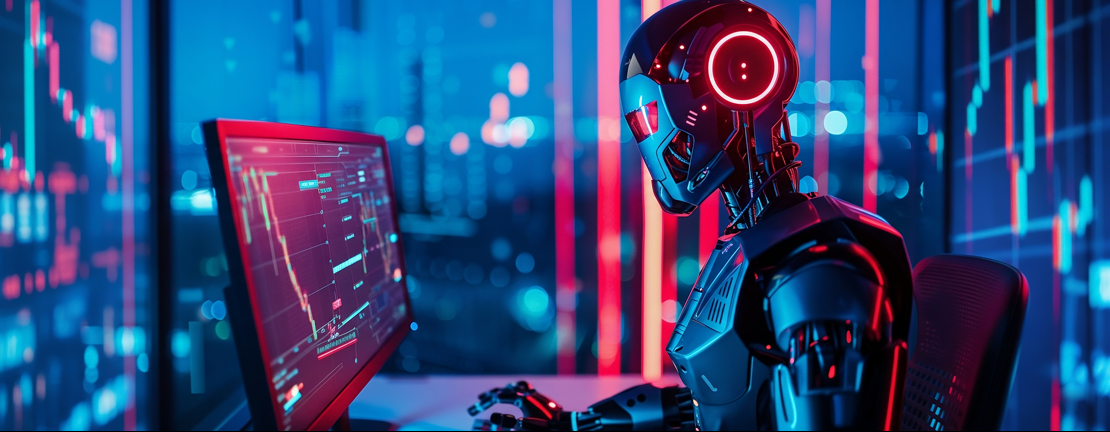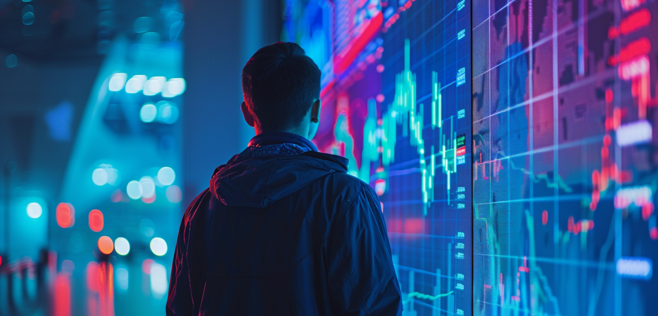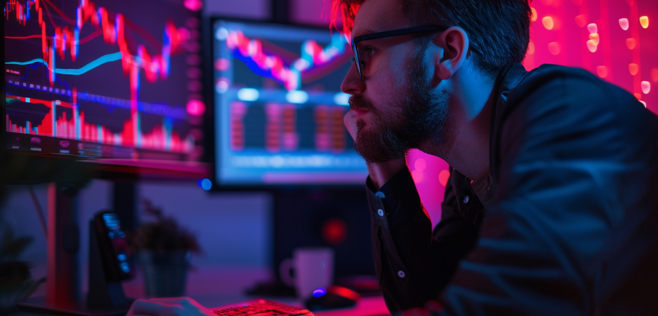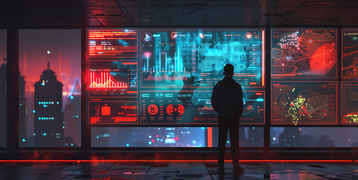Published 30 Sep 2025
Crypto Trading Algorithms vs Human Traders: Who's Making More Money in 2025?

AI trading algorithms process massive amounts of market data in milliseconds as human traders click their mouse buttons. These AI-powered systems analyze and execute trades at speeds no human trader could match. The automated systems work non-stop to scan thousands of assets day and night. They spot patterns and opportunities that would take humans days to find.
The race between machines and human intelligence in cryptocurrency markets has hit new peaks in 2025. Most crypto traders fail at technical analysis — about 90%. This makes AI crypto trading algorithms more popular than ever. These algorithms don't just trade faster — they execute in milliseconds. They also stay disciplined when markets turn volatile. Smart crypto trading algorithms use advanced risk management. They set stop-losses automatically and adjust positions based on immediate market conditions.
Machine learning crypto trading algorithms have grown smarter. They now analyze more market data in one minute than what a person could process in a week. But do faster computers mean better returns? Let's get into how algorithms and human traders compare in speed, emotional control, market understanding, and bottom-line profits in today's crypto markets.
Speed, Accuracy, and Execution Time
The crypto market's ever-changing nature has created a huge gap between what automated systems and human traders can achieve. This difference becomes clear when we look at how trades actually happen.
Trade Execution Speed: Milliseconds vs Manual Clicks
Speed makes algorithms and humans worlds apart. Automated crypto trading algorithms complete trades in milliseconds — some as fast as 0.001 milliseconds. Human traders need at least 10-15 seconds to analyze and execute trades. This speed gap becomes vital during volatile periods when market opportunities disappear in seconds. Human reflexes take 150-250 milliseconds. This makes it impossible for manual traders to keep up with high-frequency trading systems that execute thousands of trades each second.
Market Scanning: Thousands of Assets vs Limited Focus
AI systems process information way faster than humans. Machine learning crypto trading algorithms watch multiple markets at once. They spot price differences and find complex patterns. These systems can check thousands of cryptocurrencies on different exchanges. They process "millions of data points" immediately. Human traders usually watch just a few assets and indicators. They often miss opportunities while they study a single trading setup.
Latency in Decision-Making: AI Algorithms vs Human Reaction Time
Latency shows another big advantage for algorithms. By 2025, profitable crypto trading algorithms will work with delays as short as 0.01 seconds. Humans take 0.1-0.3 seconds just to react. Algorithmic traders use co-location services to cut this delay even more. They put their servers right next to the exchange infrastructure. These systems use high-speed fiber optic cables and microwave transmission to save crucial nanoseconds.
AI-driven systems stay consistent whatever the market conditions. They don't get tired, stressed, or lose focus like humans do. The best crypto trading algorithms in 2025 follow their strategies perfectly across 24-hour global markets.
Emotional Discipline and Risk Management
The numbers paint a harsh reality: 90% of retail traders lose money even with advanced tools and market data at their fingertips. These traders don't fail because they lack knowledge — their emotions often override rational decisions at vital moments.
Emotional Bias: Greed and Fear vs Logic-Based Execution
Emotions like fear and greed substantially affect cryptocurrency trading decisions. Research shows a direct link between Bitcoin's daily price swings and trading volume with gut reactions, particularly negative ones. FOMO pushes traders into rushed decisions, while their aversion to losses makes them hold onto falling positions too long as they hope for a comeback. So AI crypto trading algorithms have a clear advantage — they run purely on data and preset rules, which eliminates these psychological traps.
Risk Controls: Automated Stop-Loss vs Manual Oversight
Smart risk management gives profitable crypto trading algorithms a vital edge. AI stop-loss systems protect against losses and follow price increases upward, which creates a "ratchet effect" to lock in profits step by step. On top of that, these systems cut down false exits by analyzing order books, sentiment data, and volatility patterns. Human traders often break their own risk rules by moving stops during losses or ignoring their exit strategies when emotions take over.
Consistency in Volatile Markets: AI Stability vs Human Hesitation
Machine learning crypto trading algorithms stay steady whatever the market conditions. The best crypto trading algorithms in 2025 execute similar trades under matching conditions without wavering. During high-volatility periods when human traders typically freeze or panic, these automated systems keep working with the same discipline. While AI isn't perfect, especially during unexpected black swan events, knowing how to work without emotional interference brings substantial stability to the volatile crypto market.

Market Interpretation and Adaptability
Market data interpretation stands as the most subtle battleground between algorithms and human traders, beyond just speed and emotional control. This domain expresses both the remarkable capabilities and unexpected limitations of each approach.
News and Sentiment Analysis: Machine Learning vs Human Intuition
AI-driven crypto trading algorithms process news and social sentiment at scale exceptionally well. These systems analyze social media posts, news articles, and forum discussions to gauge market mood before prices move. Natural Language Processing (NLP) technology helps machines detect subtle changes in market psychology that might come before big price swings. To name just one example, an NLP system could spot growing positive discussions about a specific cryptocurrency on Reddit, which signals rising interest before major price changes.
All the same, human traders keep clear advantages in subtle interpretation. Experienced traders understand broader socio-economic factors, geopolitical changes, and cultural trends better than algorithms. This "sixth sense" for market dynamics, developed through years of experience, lets humans spot opportunities that algorithms might miss.
Black Swan Events: AI Limitations vs Human Flexibility
The biggest weakness of machine learning crypto trading algorithms lies in their vulnerability to black swan events — rare, unexpected occurrences with severe consequences. AI models learn from past trends, which makes unprecedented events without historical precedent almost impossible to predict. Models need updates after each crisis to account for new risks, yet the next crisis usually comes from completely different causes.
Learning Curve: Self-Updating Algorithms vs Experience-Based Growth
AI crypto trading algorithms show adaptability through continuous learning. These systems analyze huge datasets, recognize patterns, and adjust strategies based on new information. Profitable crypto trading algorithms in 2025 evolve with market trends and refine their predictions continuously.
Many experts now believe the best trading strategies come from collaborative effort rather than competition. The combination of AI's analytical strength with human strategic thinking creates a complete approach to navigating cryptocurrency markets.
Profitability in Real-World Scenarios
Ground performance data shows the true profitability gap between algorithmic and human crypto trading in 2025. The numbers paint a clear picture about who makes more money and under what circumstances.
High-Frequency Trading: AI Dominance in Scalping
Algorithms rule the high-frequency trading space. Automated systems execute 70% of all crypto trades worldwide, with total trading volume hitting $94 trillion in 2023. Crypto trading algorithms achieve almost perfect consistency. Virtu Financial's records show all but one trading day was profitable out of 1,300 over four years using algorithmic strategies. AI-driven systems work at lightning speed with 0.01 seconds latency. This speed helps them profit from price differences that last only moments.
Event-Driven Trades: Human Edge in News-Based Moves
Human traders still hold the upper hand during major market events. They excel at event-driven trading strategies that profit from investor overreactions to breaking news. Experienced traders know how to read regulatory announcements, political changes, and economic developments better than machines. Humans can predict long-term effects more accurately than AI, especially with unprecedented events that lack historical data.
Case Study: Profitable Crypto Trading Algorithms in 2025
The profitability gap has widened substantially by 2025. AI trading bots deliver 25-40% annual returns consistently, while human traders typically achieve 5-30%. These systems maintain 92% accuracy in trade predictions and win 60-80% of their trades. Automated trading systems show 23% higher profits compared to traditional methods and cut emotional trading errors by 47%.
Hybrid Models: Combining AI Speed with Human Strategy
Many successful traders now use hybrid approaches. A leading crypto hedge fund's performance soared after combining AI-driven algorithmic trading with human oversight. Individual traders who utilize AI tools see their win rates climb by about 20%. This balanced strategy uses AI for market scanning and high-frequency trades while humans handle strategic decisions and risk management.

Conclusion
Automation has clearly won the battle against human traders in crypto trading by 2025. Algorithms can process market data thousands of times faster than humans. They execute trades in milliseconds and watch countless assets without getting tired. This speed creates opportunities that manual traders simply can't see.
On top of that, emotional discipline makes a huge difference. Market volatility often causes human traders to struggle with fear, greed, and inconsistent risk management. Algorithms maintain their steadfast execution whatever the market conditions. Their calculated, cold approach eliminates psychological traps that affect 90% of retail traders.
All the same, human traders have their own advantages. Their gut feel about broader socioeconomic factors, knowing how to interpret unexpected events, and judgment from experience give unique insights that algorithms can't match. This human edge becomes vital during major market changes and black swan events where past data doesn't help much.
The profit numbers tell quite a story. AI-driven systems regularly achieve annual returns of 25-40% while human traders manage 5-30%. These machines also have much higher success rates in predicting trades. Their perfect execution and emotional detachment lead to better financial results in normal market conditions.
The future of crypto trading looks more like a blend of both approaches rather than machines taking over completely. More traders now combine algorithmic speed and consistency with human oversight. These collaborative models employ AI to scan markets and execute high-frequency trades while humans provide direction and context. Together, they create trading systems more effective than either could build alone.
The answer to "Who makes more money?" isn't simple. Algorithms rule high-frequency trading and consistent execution, but humans shine during market-changing events and unprecedented situations. Smart traders see these as complementary strengths rather than competition. Both machines and humans play vital roles in cryptocurrency markets of 2025 and beyond.
Read More




 Get RateX Pro
Get RateX Pro

 06 Jun 2024
06 Jun 2024
